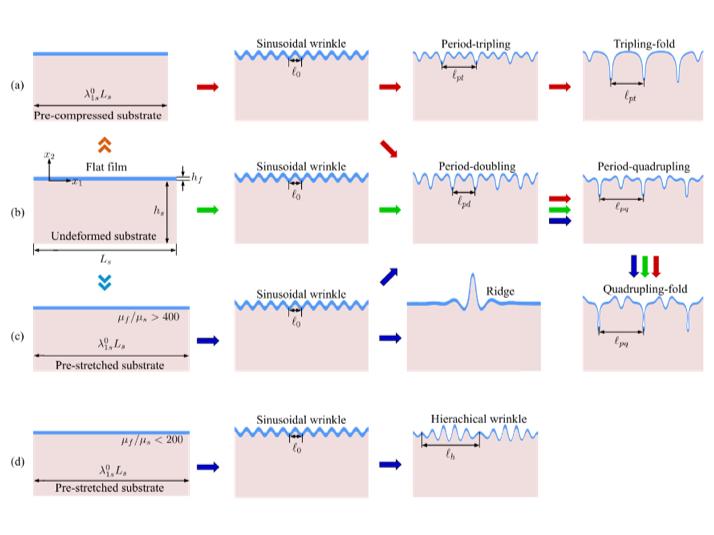
Credit: @Science China Press
Surface instability of compliant film/substrate bilayers has raised considerable interests due to its broad applications such as wrinkle-driven surface renewal and antifouling, shape-morphing for camouflaging skins, and micro/nano-scale surface patterning control. However, it is still a challenge to precisely predict and continuously trace secondary bifurcation transitions in the nonlinear post-buckling region. Fundamental understanding and quantitative prediction of morphological evolution and pattern selection are, in fact, crucial for the effective use of wrinkling as a tool for morphological design.
Lately, an article entitled “Intricate evolutions of multiple-period post-buckling patterns in bilayers”, published in SCIENCE CHINA Physics, Mechanics & Astronomy by a soft matter mechanics group at Fudan University, has reported rich successive post-buckling phenomena involving multiple-period pattern transitions (see Fig. 1), based on their lattice models of hyperelastic bilayers.
Researchers have developed lattice models to quantitatively predict the nonlinear surface morphology evolution with multiple mode transitions in hyperelasric bilayers. Based on these models, they have revealed an intricate post-buckling phenomenon involving successive bifurcations: flat-wrinkle-doubling-quadrupling-fold. They have examined effects of modulus ratio, dimension and loading types on pattern formation and evolution. With high substrate pre-tension, hierarchical wrinkles in the form of alternating packets of large and small undulations appear in the bilayer with a low modulus ratio at the secondary bifurcation, while a wrinkle-to-ridge mode transition occurs with a relatively high modulus ratio. While with a moderate substrate pre-compression and modulus ratio, the bilayer tends to evolve into a period-tripling mode. Lastly, they have provided phase diagrams based on neo-Hookean and Arruda-Boyce constitutive laws to characterize the influence of pre-stretch and modulus ratio on pattern selection (see Fig. 2). Both hyperelastic models demonstrate the same trend of mode transition and similar deformation shapes in film/substrate bilayers.
This work not only advances the fundamental understanding of nonlinear morphological transitions of soft bilayer materials, but also gives a way to quantitatively predict and design multiple-period or localized surfaces, which is promising to guide smart surface regulation in broad applications.
###
This work was supported by the National Natural Science Foundation of China (Grant Nos. 11872150, 11772094, and 11890673), the Shanghai Rising-Star Program (Grant No. 19QA1400500), and the Shanghai Chenguang Program (Grant No. 16CG01).
See the article:
Z. Cheng, and F. Xu, Intricate evolutions of multiple-period post-buckling patterns in bilayers, Sci. China-Phys. Mech. Astron. 64, 214611 (2021).
https:/
Media Contact
Xu Fan
[email protected]
Related Journal Article
http://dx.




